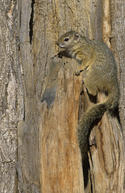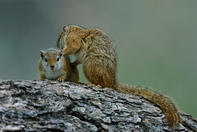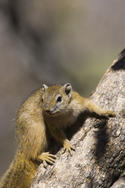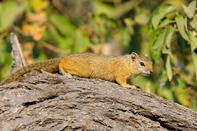Family Tree

Tree squirrels live in family groups that recognize one another through a common smell.
They are meticulous groomers, a necessary trait in small animals that can’t afford to lose energy in the form of blood to parasites, and the group odour transfers between members during allogrooming - mutual grooming stints or from sleeping together.
They also mark one another by dragging their anal glands over their mutual group members. Any animal which does not have the correct smell is chased away.
Family groups are territorial. They designate their turf with chattered vocal declarations coinciding with tail-flicks and with scented markers including urine deposits and secretions from the lip and anal glands.
The territory is primarily defended by the male who holds the highest rank in the group hierarchy. When a female is on heat she will vocalize with urgent, high-pitched chatters. These attract any male within earshot to come and attend to her.
Understandably the territorial male does not approve of all the intruders and males spend a great deal of time chasing one another around noisily at these times for access to the female. Her chatters also seem to induce other females to enter oestrus simultaneously and so the male has his hands full.
This paternity competition may be a mechanism designed to facilitate the mixing of genes.
Baby-care

Squirrels sleep and nest in hollow cavities in trees which they line with grass and leaves. These abodes are called ‘dreys’. During nesting, the females clean out their nests regularly to prevent the build-up of parasites.
During these occasions, young may need to be moved. The female moves her offspring by holding one of their back legs. The youngster clings to her shoulders in a ‘sack-of-potatoes’ manner. Newborn squirrels are altricial, blind, naked and helpless.
The parents are particularly attentive and the female remains with her young in the nest for the first few days grooming and caring for them. Even the male assists with grooming duties and remains attentive of his family throughout the breeding process.
The young wean quickly and at this point, the food supplied by adults dries up immediately.
This is to encourage the young to follow the adults and learn themselves what to eat by observing what the adults feed on. At a mere ten months old, squirrels become sexually mature and may then leave their natal groups.
Raise the Alarm

Tree squirrels are extremely vocal and their bird-like alarm rattles are a common sound in the bushveld alerting observers and other wildlife to the presence of danger, be it in the form of a snake, raptor or larger carnivore.
The noise becomes more intense as the situation progresses and absolute fear is indicated by a higher-pitched whistle.
Other squirrels within earshot of the alarm-raiser will rally together at the source of the danger to mob predators like snakes or contribute their own alarms from a safe vantage.
Sunbathing Pastime

Although tree squirrels are endothermic - ‘warm-blooded’, being small they lose heat rapidly and at colder times of the year are avid sunbathers.
They may spend a couple of hours in the mornings basking in an elevated spot to warm up before they move off to feed.
On return to the nest site in the afternoons, squirrels will again sun themselves to gain heat before the chilly night begins. Sunning sessions usually coincide with grooming sessions.
The young receive compulsory grooming from their mothers that hold them down to prevent their escape, much like human children need to be constrained at bath time!
By Megan Emmett